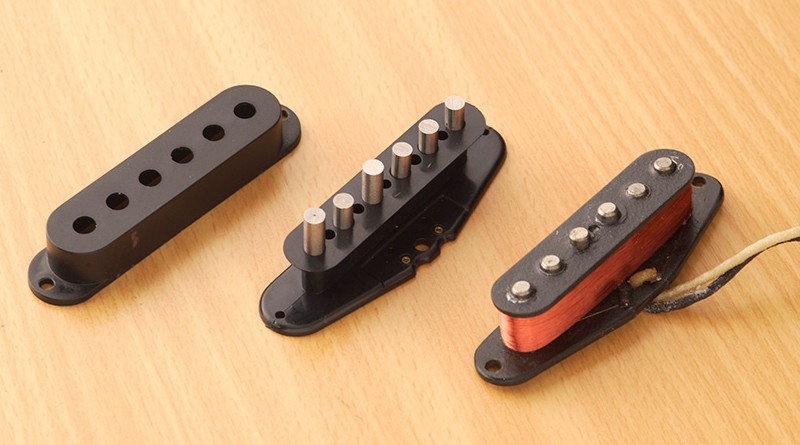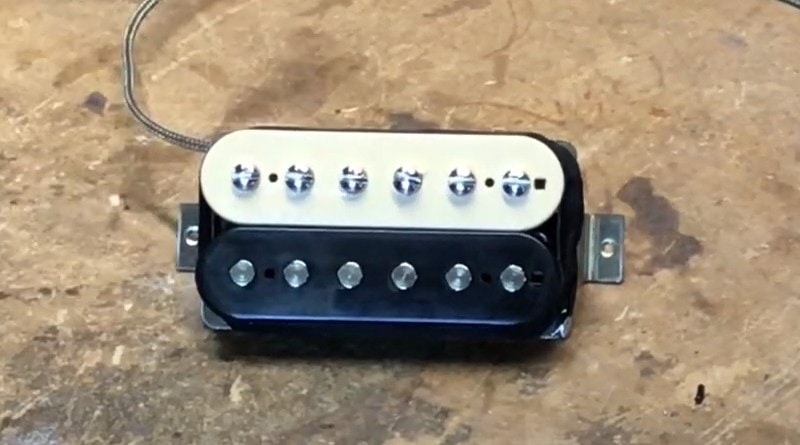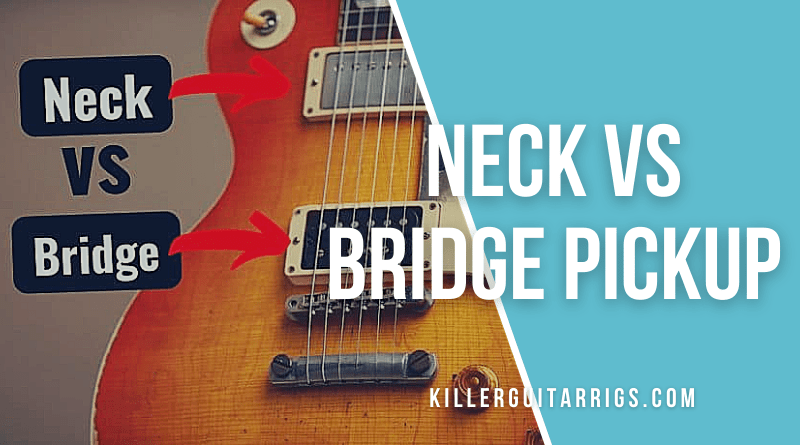Many of us have often found ourselves in a frustrating situation where we’ve spent a lot of time picking up a song by our favorite guitar player. We play the notes in the exact register with the same gear and yet somehow still don’t quite sound like them. Well, in many cases this is simply because we’re not playing it on the same pickup as they did.
While there have been many debates about the neck and the bridge pickup and which one is superior, the truth is that they are both very different. So let us dive into the unique tonality of the two and understand how to best utilize them in our music:
Contents
What Is A Guitar Pickup and How Do They Work?
An electric guitar is unable to produce sound on its own like an acoustic guitar. The pickups on the guitar convert vibrations from the strings into electrical signals using electromagnetic induction.
Pickups are usually made of ferrite or AlNiCo magnets that are wound in copper wire. Each string of the guitar has an individual pole piece that helps create a magnetic field that converts the mechanical energy of the vibrating metal strings to sound when it is passed through an amplifier.
Single Coil Pickups

Guitars such as the Fender Stratocaster or Telecaster have ‘single-coil’ pickups. They have a brighter sound, typically highlighting high frequencies. While the windings on the coil vary among different guitar models, single-coil pickups have one coil that is responsible for creating the magnetic flux that generates a current.
Humbuckers

Single-coil pickups tend to produce a ‘hum’ sound and can be quite noisy sometimes. Humbuckers pickups have two single coils bound in reverse polarity. This double-coil configuration cancels out the noise that can otherwise be heard at a frequency of 60Hz.
A Gibson Les Paul traditionally uses humbuckers and these produce a sound that is more mid and low-heavy.
Pickup Selectors
While single-pickup guitars such as the 1962 Fender Telecaster Esquire are an exception, most guitars have pickup selectors that let you choose between a bridge pickup, a neck pickup, or a combination of both.
Whether you have a single-coil, humbucker, or combination pickup configuration in your guitar, you will be able to select your pickups according to the sound you want them to create.
Some guitars such as the Fender Stratocaster or Telecaster may have a 5-way switch that allows you to select your pickup position. Others such as the Gibson Les Paul have a 3-way toggle switch on the body for the same purpose. Pickup selectors are generally located on the body of a guitar and their positioning may vary based on individual models. To know more about the different parts of the guitar, read our detailed piece on them here.
Different pickups generate different sounds. We shall explore this in detail in the next section.
Neck Pickup
The neck pickup is the first pickup below the fretboard on your guitar. Depending on what kind of guitar you have, it may either be a single-coil or a humbucker pickup. When in the neck position, the strings are looser and this results in less string tension. Neck pickups thus create a sound that amplifies low and mid frequencies more. The tone is thick, warm, and ideal for solos or melody lines.
Notable Examples
- Smoke On The Water-Deep Purple
This song is often considered a rite of passage for guitar players when they start their journey. The neck pickup is responsible for giving this iconic riff that grittiness in the tone.
- Slow Dancing In A Burning Room-John Mayer
Played through a Fender Stratocaster, this position of the pickup adds to the bluesy warmth of the guitar tone.
- Blue Sky- The Allman Brothers Band
Although we generally associate the neck pickup with guitars such as a Stratocaster or Telecaster, you can get a tone that isn’t muddy even on a Les Paul.
Bridge Pickup
On your guitar, the bridge pickup is located above the bridge. It is the bottom-most pickup on all pickup configurations. The strings have a higher tension towards the bridge, this results in the guitar tone sounding brighter with prominent high-end frequencies. The high resistance means that the sound output is significantly more than that of a neck pickup.
The bridge pickup works great when playing rhythm or even riffs. We shall take a look at which pickup to use for which part of the song in the later sections.
Notable Examples
- Welcome To The Jungle- Guns N’ Roses
Slash is known for extensively using the bridge pickup on a Les Paul for a tone that cuts through the other elements in the band. While his guitar sound is heavy, it is also bright and heavy on the treble.
- Comfortably Numb- Pink Floyd
David Gilmour also uses his bridge pickup extensively. You can hear him switch during the solos during this song to make them stand out.
- Didn’t It Rain- Sister Rosetta Tharpe
Known as the ‘Godmother of Rock n’ Roll’, Sister Rosetta Tharpe may have used the bridge pickup on the Gibson SG but to extract this tone, one needs to master her unique fingerpicking style which inspired generations of musicians.
Middle Pickups
Now that we know how different the neck and the bridge pickups sound, you must be wondering if there was a way to somehow combine the two. The middle pickup is thus a combination of the two. These have a neutral sound and do not highlight one particular frequency band.
They can also be used in the combination of neck/middle or bridge/middle for exciting new tones.
A neck/middle combination results in a clear and bouncy tone that is not too shrill whereas a bridge/middle sound has attack and warmth.
Single Pickup Guitars
While most guitars have 2 or 3 pickups, you may have noticed that some only have 1. These guitars may not offer a lot of versatility in terms of sound, but they have rich tones. To emulate a neck and bridge pickup configuration in these guitars, you can turn the ‘tone’ knob up or down to add color to your sound.
Single pickup guitars have been played by the likes of Keith Richards, Billie Joe Armstrong, Joan Jett, and Martie Friedman, to name a few.
Factors That Determine Differences
- The number of (usually copper) wires used varies between a neck and a bridge pickup. Wider coils give the sound depth and body, whereas narrow coils make the pickup sound brighter. The gauge of the wire used is also an important factor.
- Neck pickups have a lower string resistance and thus a lower output in comparison to bridge pickups. This is because the strings vibrate more towards the neck than the bridge. Bridge pickups tend to have more output to compensate for the lower string amplitude near the bridge.
- Certain elements such as the strength of the magnets used, the casing where the pickup is housed, and the size of the magnetic field created, give both bridge and neck pickups their unique sound.
When To Use What
Every guitar player has a unique perspective on their sound and their ideal tone. But since the bridge and the neck pickups produce radically different sounds, here are some of the best ways to utilize both:
Genre
Neck pickups work best for blues and jazz whereas the bridge pickup is more ideal for rock and metal.
Guitar Type
On single-coil pickups such as the ones found in Stratocasters, the bridge pickup gives the sound more body since playing on the neck pickup can sound too treble-heavy. For humbuckers, the opposite works the best. However, this is a matter of personal preference and you should experiment with all the pickups on your guitar to figure out which one works out the best for you.
Song Structure
Bridge pickups compliment rhythm guitar playing whereas the neck pickup is used for solos and lead guitars.
Other Factors That Determine Your Sound
While the pickups lay down the foundation of your tone, the other elements such as an amp or effects also play an important role.
Depending on the sound you are going for, it’s best to start with the pickup of your choice and then make adjustments to your amp and then your effects. While there is no right or wrong way to go about this, the more you experiment with a combination of the three, the better understanding you will have. Once you have found your sweet spot, it will become muscle memory to adjust your tone whether you are recording music or performing it live.
Many guitar players check the amp sound on their pickups first and then tweak their effects or switch between the pickups as needed. This is because changing the amp settings mid-song or performance can radically alter the overall mix, especially when playing in a band. This is not ideal or practical.
Frequently Asked Questions
Q. How many pickups does a guitar have?
Different guitars have a different number of pickups. It is common for an electric guitar to have 2 or 3 pickups. Some guitars also have 1 pickup. They can be a combination of SSS, SSH, or even HHH. (Here, ‘S’ represents single-coil and ‘H’ is a humbucker.)
Q. Can I change the pickups on my guitar?
Yes. Manufacturers such as Seymour Duncan, EMG, DiMarzio, etc produce pickups that you can replace the default pickups with, depending on your sound preference – there are very active markets for different humbuckers, as well as specific pickups for strats, teles, Les Pauls, acoustics – even passive pickups for metal! For beginners, it is best to not try to replace the pickups themselves but to consult with a luthier to see if they fit the guitar and make necessary changes to the body.
Q. Do acoustic guitars have pickups?
Yes. Just like electric guitars, you can amply the sound of acoustic guitars. Some models come equipped with pickups such as Fishman. However, if you are planning to install piezo or blended system pickups, they might alter the sound of the guitar since you are making modifications to the body. A microphone pickup is always a safer bet.
Q. What pickups do bass guitars have?
Bass guitars usually have 2 pickups that can either be single or split coils. Like electric guitars, you can switch between a neck and a bridge pickup to tweak your tone.
Q. What is the tone knob on a guitar used for?
The tone knob determines the frequency of your sound. A lower level reduces high frequencies and is more low-end heavy whereas a higher level amplifies the high and mid-range frequencies.
Q. Why are some pickups angled?
Angled or slanted pickups tend to give us greater control over the low-end strings. They enhance treble in the high strings and bass in the lower ones. It is common to find an angled single-coil pickup towards the bridge. The position of the pickup affects its tone.
Final Thoughts on Neck Vs Bridge Pickup
While practicing with dedication is key to being a good guitar player, understanding your instrument is what makes you a great one. Since every guitar is as unique as the player, spend some time playing around with the different pickup combinations on your guitar.
The best way to understand the difference between the neck, bridge, and mid pickups on your guitars is by plugging it into an amp or DAW without any effects. Hearing the clean tones first will help you not just build on them, but also know which one fits best in your music.
If you are not comfortable switching pickups and have a preference for one, then that is completely normal. At the end of the day if you are content with the tone and enjoy hearing it when you play, then your audience will have a good time too!
Check out these other articles you might like:


